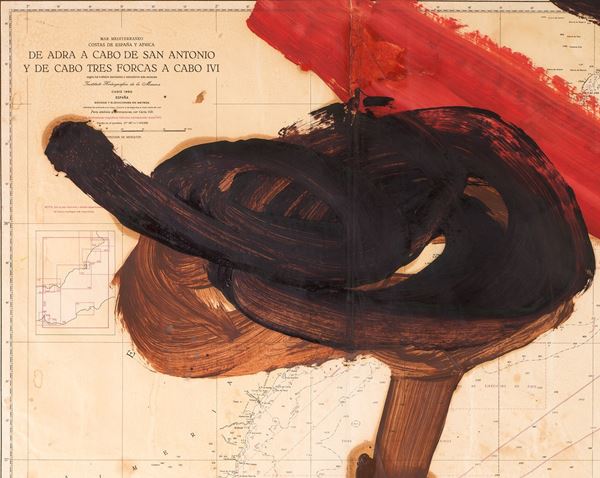111
Julian Schnabel © (1951)
De Adra Cabo de San Antonio y de Cabo Tres Forcas a Cabo IVI, 2007
Signed and dated Schnabel 07 lower left
Oil on map mounted on linen
cm 123,8x93,4
Provenance:
New York, Westwater Sperone, as per label on the reverse
Exhibitions:
Julian Schnabel, Navigation Drawings, Sperone Westwater, New York, from 8th to 16th February 2008, illustrated in the exhibition catalogue
-
Painter, sculptor and director of international renown, Julian Schnabel (New York, 1951) stands out for his amazing metamorphic ability and the overwhelming expressive force that communicates through his varied and heterogeneous production. In the world of cinema he fascinates audiences and critics with films such as Basquiat of 1996, but it is in painting that his expressive potential reaches its peak, becoming in the eighties the leading exponent of the neo-expressionist internationalist movement.
Schnabel is famous for using as "support" for the realization of his works an endless series of materials, from velvet to tarpaulin, from pieces of wood from all over the world to sails, photographs, carpets, tarpaulins and in general to any flat surface inspires his creative processes. Among his most successful experiments, and now iconographic of the artist, the one concerning nautical maps, of which the work of 2007 presented here is part.
The "Navigation Drawings" are works painted in oil on vintage nautical maps, an example of an art inclusive of things that are common and unusual at the same time. Schnabel mainly uses the old Stanford maps, those that were hung on the rollers on the walls of the classrooms, and chooses those that depict exotic places and with sensational names, such as "De Adra a a Cabo de San Antonio y de Cabo Tres Forcas a Cabo IVI". By rotating the map on one side or turning it upside down, the artist releases its informative content; and his seemingly random pictorial sign, which seems to move like a vortex, is actually precise and studied, and always refers to the symbol of a cross. His palette is opaque and dominated by a reddish brown, which he himself indicates as the color of dried blood. And it is precisely to color that Schnabel entrusts the task of transmitting emotions and truth.
The "Navigation Drawings" are works painted in oil on vintage nautical maps, an example of an art inclusive of things that are common and unusual at the same time. Schnabel mainly uses the old Stanford maps, those that were hung on the rollers on the walls of the classrooms, and chooses those that depict exotic places and with sensational names, such as "De Adra a a Cabo de San Antonio y de Cabo Tres Forcas a Cabo IVI". By rotating the map on one side or turning it upside down, the artist releases its informative content; and his seemingly random pictorial sign, which seems to move like a vortex, is actually precise and studied, and always refers to the symbol of a cross. His palette is opaque and dominated by a reddish brown, which he himself indicates as the color of dried blood. And it is precisely to color that Schnabel entrusts the task of transmitting emotions and truth.
"Schnabel’s work has its roots in exploring and trying to define the difference between epiphany and cliché. In his recent series of drawings on nautical charts this tension is articulated in direct terms. Often a single gesture or a set of pictorial forms depicts the presence of the painter, a compressed or distilled essence... Through his treatment each map becomes a backdrop for events - pictorial events that he stages, inviting to narration" (David Moos, "Sounding in Fathoms: the recent navigation drawings of Julian Schnabel").
€ 26.000,00 / 32.000,00
Estimate
€ 25.000,00
Amount including auction fees
Awarded






